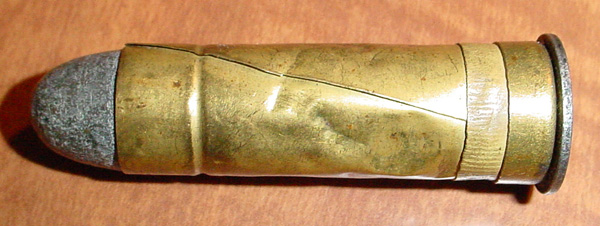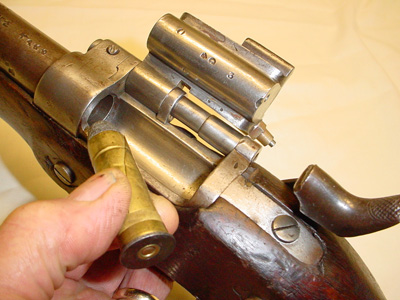Around the midpoint of the 19th Century, the benefits of breechloading were becoming obvious to all but the most entrenched military minds. A man with a converted rifled musket could fire 3 times faster than the muzzleloader. European armies began the arduous task of converting their vast stocks of muskets to breechloading arms. One of those conversions was Britain's first breechloader, the Snider rifle.

picture from Adam's Guns
The conversion they used was an American design, by Jacob Snider. Many other designs were proposed (everyone was busy trying to invent a solution) but the Snider design removed the least amount of wood, which could seriously weaken the rifle. The .577 caliber Enfield was only 10 years old, and large stocks existed. The modifications included a shoe and a hinged block, that when opened and pulled back could extract the shell. The block also had a firing pin through it at an angle so that the original hammer could still be used. Simple and robust.
The original design, in use, could eventually loosen and led to blocks blowing open after being fired. A solution was found by Edward Bond of the London Small Arms Co. and accepted. It consisted of a locking latch on the breech, and came to be known as the Bolted or Improved breech. The London Small Arms Company along with the Birmingham Small Arms Company helped Enfield fullfill the orders from the British Government.
The bullet was unique also as it consisted of a coiled brass case, with a percussion cap fixed to the base. The hollow base of the bullet had an iron plug to help expand the skirt of the bullet to take the rifling. The bullet looks fragile, but actually worked better than the latter .450 in desert conditions. The bullet weighed 480 grains, and followed the wisdom of the day on knock down power.

Ballistics were terrible as opposed to modern designs, but was still well used by the British Army. They followed the artillery idea of the beaten zone, where the officer would call out the range to be set on the rifles, and when the enemy entered that zone, the hail of lead that fell upon them was very discouraging.
There was a brisk commercial trade for these rifles also. In Trader Horn, Alfred Horn describes his adventures up the Ogowe River, with a boatload of men and Snider rifles, which came in very handy against rogue elephants and natives.

There still are enthusiasts who shoot these rifles, and as brass is hard to come by, usually make new bullets out of 24 gauge brass shotgun shells. To conserve the hard to get brass, some guys just prime the case and load the rest down the muzzle. There are still some Canadian ammunition around, though the cadet round is somewhat smaller. IMA still sells loaded Snider rounds for 115 bucks for a box of 20.
These guns lasted in service for a long time. Although the Martini-Henry replacement came out in 1874, it took many years to fill out the orders for the British Army. Austrailian and Canadian units held onto theirs for years. The Indian Army had theirs far longer, as the British never forgot the Sepoy Mutiny, and didn't want them to have modern guns.
Sniders were used in the Japanese Satsuma rebellion of 1877 and the Boshin Civil War during 1868 to 1869. The Japanese had furiously modernized their equipment after being opened to the West in 1854 by Commodore Perry. Arms of all types were used in this war. In fact, in the movie, The Last Samurai, the inference that the Samurai disdained modern arms couldn't be further from the truth. They had lots of Sniders, and other modern weaponry.
The Snider period is one of relative quiet for the British Army, and it's first large scale engagement occurred during the 2nd Afghan War at Ali Masjid (a fort on the Khyber pass), and only in the hands of Indian troops, as the Brits kept the new Martini-Henry for themselves. The Indian troops aquitted themselves well with few casualties for the British forces, and heavy losses for the Afghans. Also noteable was the British use of elephants to pull their seige guns up the Khyber pass (If only Hannibal had seige guns!).
Snider breechloading rifle -Extract from 1866
Loading and firing the Snider rifle
Reloading equipment for the Snider

